
БУВІДАЛ 96 мг РОЗЧИН ДЛЯ ІН'ЄКЦІЙ ПРОЛОНГОВАНОЇ ДІЇ
Запитайте лікаря про рецепт на БУВІДАЛ 96 мг РОЗЧИН ДЛЯ ІН'ЄКЦІЙ ПРОЛОНГОВАНОЇ ДІЇ

Інструкція із застосування БУВІДАЛ 96 мг РОЗЧИН ДЛЯ ІН'ЄКЦІЙ ПРОЛОНГОВАНОЇ ДІЇ
Введення
Опис: інформація для користувача
Buvidal 8мг розчин для ін'єкційз тривалою дією
Buvidal 16мг розчин для ін'єкційз тривалою дією
Buvidal 24мг розчин для ін'єкційз тривалою дією
Buvidal 32мг розчин для ін'єкційз тривалою дією
Buvidal 64мг розчин для ін'єкційз тривалою дією
Buvidal 96мг розчин для ін'єкційз тривалою дією
Buvidal 128мг розчин для ін'єкційз тривалою дією
Buvidal 160мг розчин для ін'єкційз тривалою дією
бупренорфін
Всімістно прочитайте цей листок перед тим, як почати використовувати цей лікарський засіб, оскільки він містить важливу інформацію для вас.
- Збережіть цей листок, оскільки вам може знадобитися знову його прочитати.
- Якщо у вас є якісь запитання, проконсультуйтеся з вашим лікарем, фармацевтом або медсестрою.
- Якщо ви відчуваєте побічні ефекти, проконсультуйтеся з вашим лікарем, фармацевтом або медсестрою, навіть якщо це побічні ефекти, які не вказані в цьому листку. Див. розділ 4.
Зміст листка
- Що таке Buvidal і для чого він використовується
- Що вам потрібно знати перед тим, як почати використовувати Buvidal
- Як застосовується Buvidal
- Можливі побічні ефекти
- Зберігання Buvidal
- Зміст упаковки та додаткова інформація
1. Що таке Buvidal і для чого він використовується
Buvidal містить активну речовину бупренорфін, який є типом опіоїдного лікарського засобу. Він використовується для лікування залежності від опіоїдів у пацієнтів, які також отримують медичну, соціальну та психологічну підтримку.
Buvidal показаний для дорослих і підлітків віком від 16 років і старше.
2. Що вам потрібно знати перед тим, як почати використовувати Buvidal
Не використовуйте Buvidal:
- якщо ви алергічні на бупренорфін або на інші компоненти цього лікарського засобу (перелічені в розділі 6)
- якщо у вас є серйозні проблеми з диханням
- якщо у вас є серйозні проблеми з печінкою
- якщо у вас є інтоксикація алкоголем або у вас є тремор, потовиділення, тривога, сплутаність або галюцинації, викликані алкоголем
Попередження та застереження
Проконсультуйтеся з вашим лікарем перед тим, як використовувати Buvidal, якщо у вас є:
- астма або інші проблеми з диханням
- будь-яка хвороба печінки, наприклад, гепатит
- серйозна ниркова недостатність
- певні проблеми з серцевим ритмом (синдром довгого QT або подовжений інтервал QT)
- низький артеріальний тиск
- ви недавно мали травму голови або хворобу мозку
- урологічний розлад (особливо пов'язаний з збільшенням розміру передміхурової залози у чоловіків)
- проблеми з щитоподібною залозою
- кортикостероїдний розлад (наприклад, хвороба Аддісона)
- проблеми з жовчним міхуром
- депресія або інші захворювання, які лікуються антидепресантами. Використання цих лікарських засобів разом з Buvidal може викликати серотоніновий синдром, який може бути смертельним (див. "Інші лікарські засоби та Buvidal").
- якщо ви коли-небудь мали алергічну реакцію на латекс
Важливі аспекти, які потрібно враховувати
- Проблеми з диханням:Деякі люди померли через дуже повільне або поверхневе дихання, викликані прийомом бупренорфіну з іншими депресорами центральної нервової системи (речовинами, які сповільнюють деякі активності мозку), такими як бензодіазепіни, алкоголь або інші опіоїди.
- Сонливість:Цей лікарський засіб може викликати сонливість, особливо коли його використовують з алкоголем або іншими депресорами центральної нервової системи (речовинами, які сповільнюють деякі активності мозку), такими як бензодіазепіни, інші лікарські засоби, які викликають сонливість, прегабалін або габапентин.
- Залежність:Цей лікарський засіб може викликати залежність.
- Пошкодження печінки:Можуть виникнути пошкодження печінки при прийомі бупренорфіну, особливо при неправильному використанні. Це також може виникнути через вірусні інфекції (хронічний гепатит С), зловживання алкоголем, анорексію (розлад харчування) або прийом інших лікарських засобів, які можуть пошкодити печінку. Ваш лікар може призначити вам аналіз крові з регулярними інтервалами для контролю стану вашої печінки. Повідоміть вашому лікареві, якщо у вас є проблеми з печінкою перед тим, як почати лікування Buvidal.
- Симптоми абстиненції:Цей лікарський засіб може викликати симптоми абстиненції, якщо ви приймаєте його менше ніж за 6 годин після прийому опіоїду короткої дії (наприклад, морфіну, героїну) або менше ніж за 24 години після прийому опіоїду тривалої дії, такого як метадон.
- Артеріальний тиск:Цей лікарський засіб може викликати раптове зниження вашого артеріального тиску, що може викликати відчуття легкості, якщо ви встаєте занадто швидко, коли сидите або лежите.
- Діагностика медичних захворювань, не пов'язаних з Buvidal:Цей лікарський засіб може маскувати біль, що може ускладнити діагностику деяких захворювань. Не забудьте повідомити вашому лікареві, що ви приймаєте цей лікарський засіб.
- Розлади дихання під час сну:Buvidal може викликати розлади дихання під час сну, такі як апное сну (перерви дихання під час сну) та гіпоксемія під час сну (низький рівень кисню в крові). Симптоми можуть включати перерви дихання під час сну, нічні пробудження через труднощі з диханням, труднощі з підтриманням сну або надмірна сонливість вдень. Зв'яжіться з вашим лікарем, якщо ви або хтось інший спостерігає ці симптоми. Ваш лікар може розглянути можливість зниження дози.
Толерантність, залежність і звикання
Цей лікарський засіб містить бупренорфін, опіоїдну речовину. Повторне використання опіоїдів може зменшити ефективність лікарського засобу (ваш організм звикає до лікарського засобу, це називається толерантністю). Повторне використання бупренорфіну також може викликати залежність, зловживання та звикання, що може призвести до потенційно смертельної передозування.
Залежність або звикання можуть зробити вас відчувати, що ви вже не контролюєте кількість лікарського засобу, який вам потрібно приймати, або з якою частотою ви повинні його приймати.
Ризик залежності або звикання варіюється залежно від людини. Ви можете мати більший ризик залежності або звикання до бупренорфіну, якщо:
- Ви або хтось з вашої сім'ї має історію зловживання алкоголем, лікарськими засобами чи забороненими речовинами ("залежність").
- Ви курите.
- Ви коли-небудь мали проблеми з вашим станом духу (депресія, тривога або розлад особистості) або приймали лікування у психіатра за інші захворювання.
Якщо ви відчуваєте якісь з цих ознак, коли приймаєте бупренорфін, це може бути ознакою того, що ви стали залежними або звикли:
- Вам потрібно приймати лікарський засіб протягом тривалого часу, ніж рекомендовано вашим лікарем.
- Вам потрібно приймати більшу дозу, ніж рекомендовано.
- Ви приймаєте лікарський засіб за іншими причинами, ніж ті, які призначені, наприклад, "щоб заспокоїтися" або "щоб допомогти вам заснути".
- Ви зробили повторні спроби припинити або контролювати використання лікарського засобу, але безуспішно.
- Ви не відчуваєте себе добре, коли припиняєте приймати лікарський засіб, і відчуваєте себе краще, коли знову починаєте його приймати ("симптоми абстиненції").
Якщо ви відчуваєте якісь з цих ознак, проконсультуйтеся з вашим лікарем, щоб обговорити найбільш підходящу стратегію лікування для вашого випадку, включаючи те, коли потрібно припинити приймати лікарський засіб і як це зробити безпечно (див. розділ 3 "Якщо ви припиняєте лікування Buvidal").
Діти та підлітки
Buvidal не повинен використовуватися у дітей молодших за 16 років. Ваш лікар буде спостерігати за вами з особливою увагою, якщо ви підліток (16-17 років).
Інші лікарські засоби та Buvidal
Повідоміть вашому лікареві, якщо ви використовуєте, недавно використовували або можете використовувати інші лікарські засоби.
Деякі лікарські засоби можуть збільшити побічні ефекти Buvidal і можуть викликати дуже серйозні реакції.
Особливо важливо повідомити вашому лікареві, якщо ви приймаєте:
- бензодіазепіни(використовуються для лікування тривоги або розладів сну). Прийом високих доз бензодіазепінів разом з Buvidal може викликати смерть через те, що обидва лікарські засоби можуть зробити дихання повільнішим і поверхневим (резpirаторна депресія). Якщо вам потрібно бензодіазепін, ваш лікар призначить вам правильну дозу.
- габапентиноїди(габапентин або прегабалін)(використовуються для лікування епілепсії або невропатичного болю). Прийом високих доз габапентиноїду може викликати смерть через те, що обидва лікарські засоби можуть зробити дихання повільнішим і поверхневим (резpirаторна депресія). Ви повинні приймати дозу, яку призначив ваш лікар.
- алкоголь або лікарські засоби, які містять алкоголь. Алкоголь може погіршити седативний ефект цього лікарського засобу.
- інші лікарські засоби, які можуть викликати сонливістьвикористовуються для лікування захворювань, таких як тривога, безсоння, судоми (атаки) та біль. Ці лікарські засоби, коли приймаються разом з Buvidal, можуть сповільнити деякі активності мозку, і зменшити ваш рівень свідомості та здатність керувати транспортними засобами та використовувати машини правильно.
До прикладів лікарських засобів, які можуть викликати сонливість або зробити вас менш свідомими, належать:
- інші опіоїди, такі як метадон, певні анальгетики та антикашльові засоби. Ці лікарські засоби також можуть збільшити ризик передозування опіоїдами
- антидепресанти (використовуються для лікування депресії)
- седативні антигістаміни (використовуються для лікування алергічних реакцій)
- барбітурати (використовуються для лікування сну або седації)
- певні анксіолітики (використовуються для лікування тривожних розладів)
- антипсихотики (використовуються для лікування психіатричних розладів, таких як шизофренія)
- клонідин (використовується для лікування артеріальної гіпертензії)
- опіоїдні анальгетики. Можливо, ці лікарські засоби не діятимуть правильно, якщо приймати їх разом з Buvidal, і можуть збільшити ризик передозування.
- налтрексон і налмефен(використовуються для лікування залежності) оскільки вони також можуть запобігти правильній дії Buvidal. Ви не повинні приймати їх одночасно з цим лікарським засобом.
- певні антиретровірусні лікарські засоби(використовуються для лікування ВІЛ-інфекції) такі як ритонавір, нелфінавір, індінавір, оскільки вони можуть збільшити ефекти цього лікарського засобу.
- певні антифунгальні лікарські засоби(використовуються для лікування грибкових інфекцій) такі як кетоконазол, ітраконазол, оскільки вони можуть збільшити ефекти цього лікарського засобу.
- макролідні антибіотики(використовуються для лікування бактеріальних інфекцій) такі як кларитроміцин та еритроміцин, оскільки вони можуть збільшити ефекти цього лікарського засобу.
- певні антиепілептичні лікарські засоби(використовуються для лікування епілепсії) такі як фенобарбітал, карбамазепін та фенітоїн, оскільки вони можуть зменшити ефект Buvidal.
- ріфампіцин(використовується для лікування туберкульозу). Рифампіцин може зменшити ефект Buvidal.
- інгібітори моноамінооксидази(використовуються для лікування депресії) такі як фенелзін, ізокарбоксазід, іпроніазід та транілципромін, оскільки вони можуть збільшити ефекти цього лікарського засобу.
- антидепресантитакі як моклобемід, транілципромін, циталопрам, есциталопрам, флуоксетин, флуvoxамін, пароксетин, сертралін, дулоксетин, венлафаксин, амітріптилін, доксепін або триміпрамін. Ці лікарські засоби можуть взаємодіяти з Buvidal, і ви можете відчувати симптоми, такі як м'язові спазми, агітація, галюцинації, кома, надмірне потовиділення, тремор, гіперрефлексія, підвищення м'язового тонусу, температура тіла вище 38 °C. Зв'яжіться з вашим лікарем, якщо ви відчуваєте ці симптоми.
- лікарські засоби, які використовуються для лікування алергії та лікування нудоти чи блювоти під час подорожей(антигістаміни або антиеметики).
- м'язові релаксанти
- лікарські засоби для лікування хвороби Паркінсона
Використання Buvidal з алкоголем
Не приймають алкоголь під час використання Buvidal (див. розділ 2 попередження та застереження). Прийом алкоголю з цим лікарським засобом може збільшити сонливість і може збільшити ризик розвитку проблем з диханням.
Вагітність та лактація
Якщо ви вагітні або перебуваєте в період лактації, вважаєте, що можете бути вагітні або плануєте вагітність, проконсультуйтеся з вашим лікарем перед тим, як використовувати цей лікарський засіб. Не відомі ризики використання Buvidal у вагітних жінок. Ваш лікар допоможе вам вирішити, чи потрібно продовжувати приймати лікарський засіб під час вагітності.
Прийом цього лікарського засобу під час вагітності може викликати симптоми абстиненції, включаючи проблеми з диханням у вашої новонародженої дитини. Це може статися через кілька годин або днів після народження.
Проконсультуйтеся з вашим лікарем перед тим, як використовувати Buvidal під час лактації, оскільки цей лікарський засіб виділяється в грудне молоко.
Керування транспортними засобами та використання машин
Можливо, Buvidal викликатиме сонливість і легкість. Це більш імовірно на початку лікування та при зміні дози. Ці ефекти можуть погіршитися, якщо ви приймаєте алкоголь або інші седативні лікарські засоби. Не керуйте транспортними засобами, не використовуйте інструменти чи машини, і не виконуйте небезпечні дії, поки не дізнаєтеся, як цей лікарський засіб впливає на вас.
Buvidal містить алкоголь
Buvidal 8 мг, 16 мг, 24 мг і 32 мг містять 95,7 мг алкоголю (етанолу) в кожному мл (10% мас./об.). Кількість в одній дозі цього лікарського засобу еквівалентна менш ніж 2 мл пива або 1 мл вина.
Мала кількість алкоголю, яка міститься в цьому лікарському засобі, не викликає жодного помітного ефекту
3. Як застосовується Бувідал
Бувідал повинен застосовуватися тільки кваліфікованими медичними працівниками.
Бувідал у дозах 8 мг, 16 мг, 24 мг і 32 мг застосовується один раз на тиждень. Бувідал у дозах 64 мг, 96 мг, 128 мг і 160 мг застосовується один раз на місяць.
Ваш лікар визначить найкращу дозу для вас. Під час лікування лікар може коригувати дозу залежно від того, як діє препарат.
Початок лікування
Перша доза Бувідалу буде введена, коли у вас будуть явні ознаки абстиненції.
Якщо ви залежні від опіоїдів короткої дії (наприклад, морфін або героїн), перша доза Бувідалу буде введена не раніше ніж за 6 годин після останнього вживання опіоїдів.
Якщо ви залежні від опіоїдів тривалої дії (наприклад, метадон), то доза метадону буде зменшена до менше 30 мг на добу перед початком лікування Бувідалом. Перша доза цього препарату буде введена не раніше ніж за 24 години після останнього вживання метадону.
Якщо ви не приймаєте бупренорфін (активний інгредієнт Бувідалу) сублінгвально (під язиком), то рекомендується початкова доза 16 мг, з однією або двома додатковими дозами по 8 мг Бувідалу, які вводяться з інтервалом не менше одного дня під час першого тижня лікування. Це означає, що цільова доза під час першого тижня лікування становить 24 мг або 32 мг.
Якщо ви раніше не приймали бупренорфін, вам буде призначена сублінгвальна доза 4 мг бупренорфіну, і вас буде спостерігати протягом однієї години перед введенням першої дози Бувідалу.
Можна використовувати місячне лікування Бувідалом, якщо це показано вам, після досягнення стабілізації з Бувідалом у тижневому лікуванні (чотири тижні лікування або більше, коли це практично).
Якщо ви вже приймаєте сублінгвальний бупренорфін, ви можете почати приймати Бувідал наступного дня після останнього лікування. Лікар призначить вам правильну початкову дозу Бувідалу, залежно від дози сублінгвального бупренорфіну, який ви зараз приймаєте.
Продовження лікування та коригування дози
Під час тривалого лікування Бувідалом лікар може збільшувати або зменшувати вашу дозу залежно від ваших потреб. Вас можна перевести з тижневого лікування на місячне та з місячному на тижневе. Лікар призначить вам правильну дозу.
Під час тривалого лікування вам може бути призначена додаткова доза 8 мг Бувідалу між тижневими або місячними лікуваннями, якщо лікар вважає це необхідним для вас.
Максимальна доза на тиждень, якщо ви приймаєте тижневе лікування Бувідалом, становить 32 мг з додатковою дозою 8 мг. Максимальна доза на місяць, якщо ви приймаєте місячне лікування Бувідалом, становить 160 мг.
Шлях введення
Бувідал вводиться як одна ін'єкція під шкіру (субкутанно) в будь-яку з дозволених зон ін'єкції: сідниці, стегна, живіт або руки. Ви можете отримувати кілька ін'єкцій в одній зоні, але точне місце ін'єкції повинно змінюватися для кожної тижневої та місячної ін'єкції з мінімальним інтервалом у 8 тижнів.
Якщо ви приймете більше Бувідалу, ніж потрібно
Якщо ви прийняли більше бупренорфіну, ніж потрібно, ви повинні негайно звернутися до лікаря, оскільки це може викликати дуже повільне та поверхневе дихання, що може призвести до смерті.
Якщо ви приймете надмірну кількість бупренорфіну, ви повинні негайно звернутися за медичною допомогою, оскільки передозування може викликати серйозні проблеми з диханням та потенційно смертельні наслідки. Симптоми передозування можуть включати повільніше та слабше дихання, ніж зазвичай, відчуття надмірної сонливості, нудоту, блювоту та/або труднощі з мовленням. Ви також можете відчувати зменшення розміру зіниць. Якщо ви відчуваєте відчуття передчуття, це може бути ознакою низького артеріального тиску.
Якщо ви пропустите дозу Бувідалу
Це дуже важливо, щоб ви відвідували всі призначені лікарем відвідування для отримання Бувідалу. Якщо ви пропустите відвідування, запитайте у лікаря, коли можна призначити наступну дозу.
Якщо ви припините лікування Бувідалом
Не припиняйте лікування без консультації з лікарем, який вас лікує. Припинення лікування може викликати симптоми абстиненції.
Якщо в вас є будь-які інші питання щодо використання цього препарату, запитайте у лікаря.
4. Можливі побічні ефекти
Як і всі препарати, цей препарат може викликати побічні ефекти, хоча не всі люди їх відчувають.
Повідомте своєму лікареві негайно або зверніться за невідкладною медичною допомогою, якщо ви відчуваєте побічні ефекти, такі як:
- раптові свистячі звуки, труднощі з диханням, набухання повік, обличчя, язика, губ, горла або рук; висип, свербіж, особливо на всьому тілі. Це можуть бути ознаки потенційно смертельної алергічної реакції.
- якщо ви починаєте дихати повільніше або слабше, ніж зазвичай (депресія дихання).
- якщо ви відчуваєте відчуття передчуття, оскільки це може бути ознакою низького артеріального тиску.
Повідомте своєму лікареві негайно, якщо ви відчуваєте побічні ефекти, такі як:
- сильна втома, відсутність апетиту або якщо шкіра чи очі мають жовтуватий колір. Це можуть бути симптоми пошкодження печінки.
Інші побічні ефекти:
Дуже часті побічні ефекти (можуть впливати на більше 1 з 10 осіб):
- безсоння (труднощі з сном)
- головний біль
- нудота
- потіння, синдром абстиненції, біль
Часті побічні ефекти (можуть впливати на до 1 з 10 осіб):
- інфекція, грип, біль у горлі та труднощі з ковтанням, виділення з носа
- запалення лімфатичних вузлів
- гіперчутливість
- зменшення апетиту
- тривога, агітація, депресія, ворожість, нервозність, аномальні думки, параноя
- сонливість, головокружіння, мігрень, печіння або оніміння в руках і ногах, передчуття, тремор, збільшення м'язового напруження, розлади мови
- слізоточивість очей, збільшення або зменшення розміру зіниць (темної частини ока)
- серцебиття
- низький артеріальний тиск
- кашель, коротке дихання, зевання, астма, бронхіт
- запор, блювота (нудота), біль у животі, метеоризм (гази), диспепсія, сухість у роті, діарея
- висип, свербіж, кропив'янка
- біль у суглобах, біль у спині, м'язовий біль, м'язові спазми, біль у шиї, біль у кістках
- більний менструальний цикл
- реакції в місці ін'єкції, наприклад, біль, свербіж, червоність шкіри, набухання та загустіння шкіри, набухання стоп, ніг або пальців, слабкість, загальне нездоров'я, лихоманка, озноб, синдром абстиненції новонародженого, біль у грудній клітці
- анормальні результати тестів на функцію печінки
Рідкі побічні ефекти (можуть впливати на до 1 з 100 осіб):
- інфекція шкіри в місці ін'єкції
- відчуття головокружіння або вертігону
Частота невідома (не може бути оцінена з доступних даних):
- галюцинації, відчуття щастя та збудження (ефорія)
- анормальне червоніння шкіри
- біль або труднощі з сечовипусканням
- реакції в місці ін'єкції, наприклад, відкриті виразки, запальна зона з нагромадженням гною та загибель клітин або тканин в місці ін'єкції.
Повідомлення про побічні ефекти
Якщо ви відчуваєте будь-які побічні ефекти, повідомте своєму лікареві, навіть якщо це потенційні побічні ефекти, які не перелічені в цьому листку. Ви також можете повідомити про них безпосередньо через Систему моніторингу безпеки лікарських засобів для людини: https://www.notificaram.es. Повідомляючи про побічні ефекти, ви можете допомогти надати більше інформації про безпеку цього препарату.
5. Зберігання Бувідалу
Бувідал повинен застосовуватися тільки кваліфікованими медичними працівниками. Пацієнтам не дозволяється забирати препарат додому або самостійно його вводити.
Тримайте цей препарат поза зоною досяжності дітей.
Не використовувати цей препарат після закінчення терміну придатності, вказаного на коробці або на етикетці шприца після "CAD/EXP". Термін придатності - останній день місяця, який вказано.
Не зберігайте в холодильнику або заморожуваті.
Не використовувати цей препарат, якщо ви помітите, що він містить видимі частинки або є мутним.
Бувідал призначений тільки для одного використання. Всі використані шприци повинні бути видалені.
Лікарські засоби не повинні викидатися у водопровідні труби або сміття. Запитайте у фармацевта, як видалити упаковку та лікарські засоби, які вам не потрібні. Таким чином, ви допоможете захистити навколишнє середовище.
6. Зміст упаковки та додаткова інформація
Склад Бувідалу
- Активний інгредієнт - бупренорфін
- Інші компоненти - соєвый лецитин, гліцерил олеат, безводний етанол (див. розділ 2 Бувідал містить алкоголь) (тільки у тижневій формі) та N-метилпіролідон (тільки у місячній формі).
Наступні шприци доступні:
Тижнева ін'єкція:
8 мг: шприц, наповнений 8 мг бупренорфіну у 0,16 мл розчину
16 мг: шприц, наповнений 16 мг бупренорфіну у 0,32 мл розчину
24 мг: шприц, наповнений 24 мг бупренорфіну у 0,48 мл розчину
32 мг: шприц, наповнений 32 мг бупренорфіну у 0,64 мл розчину
Місячна ін'єкція:
64 мг: шприц, наповнений 64 мг бупренорфіну у 0,18 мл розчину
96 мг: шприц, наповнений 96 мг бупренорфіну у 0,27 мл розчину
128 мг: шприц, наповнений 128 мг бупренорфіну у 0,36 мл розчину
160 мг: шприц, наповнений 160 мг бупренорфіну у 0,45 мл розчину
Вигляд Бувідалу та вміст упаковки
Бувідал - це розчин для ін'єкції з тривалою дією. Кожен шприц містить прозорий жовтуватий розчин.
Наступні розміри упаковки доступні:
Шприци, наповнені 8 мг, 16 мг, 24 мг, 32 мг, 64 мг, 96 мг, 128 мг та 160 мг розчину для ін'єкції.
Кожна упаковка містить 1 шприц з кришкою, голкою, захистом голки, пристроєм безпеки та 1 пусковою стрижнем.
Власник дозволу на розміщення продукції на ринку
Camurus AB
Rydbergs torg 4
SE-224 84 Lund
Швеція
Виробник
Rechon Life Science AB
Soldattorpsvägen 5
216 13 Limhamn
Швеція
Дата останнього перегляду цього листка: 07/03/2025
Детальна інформація про цей лікарський засіб доступна на сайті Європейського агентства з лікарських засобів: http://www.ema.europa.eu.
------------------------------------------------------------------------------------------------------------------------
Ця інформація призначена тільки для медичних працівників:
Інструкції з використання для медичних працівників
Зміст:
- Важлива інформація
- Частини шприца з захистом
- Введення
- Видалення шприца
- Важлива інформація
- Введення повинно здійснюватися в підшкірну тканину. ТІЛЬКИ.
- Не використовувати, якщо шприц з захистом пошкоджений або упаковка пошкоджена.
- Захист голки шприца з захистом може містити латекс, який може викликати алергічні реакції у людей з чутливістю до латексу.
- Обробляти шприц з захистом з обережністю, щоб уникнути уколів. Шприц з захистом містить пристрій безпеки, який активується в кінці ін'єкції. Захист голки допоможе запобігти травмам від уколів.
- Не знімайте захисний ковпачок з шприца до тих пір, поки ви не будете готові зробити ін'єкцію. Як тільки ви знімете захисний ковпачок, ніколи не намагайтесь знову надіти його.
- Видаліть шприц з захистом негайно після використання. Не повторно використовувати шприц з захистом.
- Частини шприца з захистом
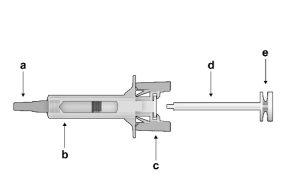

Фігура1: | Шприц з захистом: До використанняa) захист голки
| Шприц з захистом: Після використання(З активованим механізмом захисту голки) |
Увага, що менший об'єм ін'єкції майже невидимий у вікні огляду, оскільки пружина механізму безпеки "закриває" частину скляного циліндра біля голки.
- НЕ ДОТИКАЙТЕ КРИЛ ЗАХИСТУ ШПРИЦА ДО ТОГО, ЯК ВИ БУДЕТЕ ГОТОВІ ВСТАВИТИ ІН'ЄКЦІЮ. ПОДІБНА ДІЯ МОЖЕ ВИКЛИКАТИ ЗАНАДТО РАННЄ АКТИВАЦІЮ ЗАХИСТУ ШПРИЦА.
- НЕ ВИКОРИСТОВУЙТЕ ПРОДУКТ, ЯКЩО ВІН УПАВ НА ТВЕРДУ ПОВЕРХНЮ АБО ПОШКОДЖЕНИЙ. ВИКОРИСТОВУЙТЕ НОВИЙ ПРОДУКТ ДЛЯ ІН'ЄКЦІЇ.
- Введення
- Видаліть шприц з коробки: тримайте шприц за тіло захисту.
- Тримаючи шприц за вікно огляду, вставте пусковий стрижень у верхню частину поршня, повертаючи його за годинниковою стрілкою до тих пір, поки він не буде закріплений (див. Фігура 2).
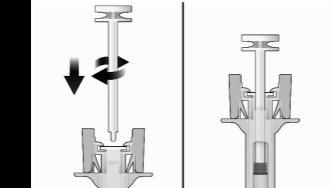
Фігура2 | До | Після |
- Обережно огляньте шприц з захистом:
- Не використовувати шприц з захистом після закінчення терміну придатності, вказаного на коробці або на етикетці шприца.
- Може бути мала повітряна булька, що є нормальним.
- Розчин повинен бути прозорим. Не використовувати шприц з захистом, якщо розчин містить частинки або є мутним.
- Виберіть місце ін'єкції. Місце ін'єкції повинно бути змінено між сідницями, стегнами, животом або руками (див. Фігура 3), очікуючи не менше 8 тижнів перед повторним введенням в попереднє місце. Ін'єкції в пасову область або на відстані менше 5 см від пупка повинні бути уникнені.
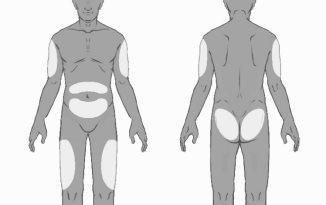
Фігура3
- Надягайте рукавички та очистіть місце ін'єкції рухом кола, використовуючи ватний диск з алкоголем (не входить до складу упаковки). Не торкайтеся чистої зони знову перед ін'єкцією.
- Тримаючи шприц з захистом за тіло захисту шприца, як показано (див. Фігура 4), потягніть захисний ковпачок голки прямо назовні. Видаліть захисний ковпачок голки негайно (не намагайтесь знову надіти його). Можливо, на кінчику голки буде одна крапля розчину. Це нормально.
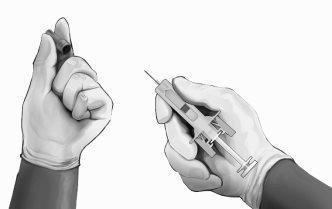
Фігура4
- Зігніть шкіру в місці ін'єкції між великим та вказівним пальцями, як показано (див. Фігура 5).
- Тримаючи шприц з захистом, як показано, та ввівши голку під кутом 90 градусів, приблизно (див. Фігура 5). Потягніть голку до тих пір, поки вона не буде повністю введена.
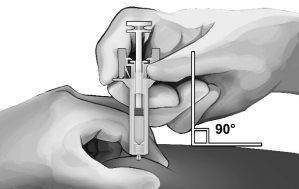
Фігура5
- Тримаючи шприц, як показано (див. Фігура 6), повільно натисніть на поршень до тих пір, поки голова не зафіксується між крилами захисту шприца, та ввійде весь розчин.
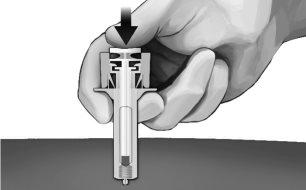
Фігура6
- Повільно витягніть голку зі шкіри. Рекомендується тримати поршень повністю натиснутим, поки ви обережно витягуєте голку з місця ін'єкції (див. Фігура 7).

Фігура7
- Одразу після видалення голки зі шкіри повільно витягніть палець з поршня та дозвольте захисту шприца автоматично закрити голку (див. Фігура 8). Можливо, на місці ін'єкції буде мала кількість крові, якщо це необхідно, очистіть її ватним диском або газою.
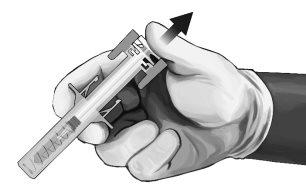
Фігура8
- Видалення шприца
Видалення невикористаного препарату та всіх матеріалів, які були в контакті з ним, повинно здійснюватися згідно з місцевими правилами.
- Країна реєстрації
- Діючі речовини
- Потрібен рецептТак
- Виробник
- Інформація є довідковою і не є медичною порадою. Перед прийомом будь-яких препаратів обов'язково проконсультуйтеся з лікарем. Oladoctor не несе відповідальності за медичні рішення, прийняті на основі цього контенту.
- Альтернативи до БУВІДАЛ 96 мг РОЗЧИН ДЛЯ ІН'ЄКЦІЙ ПРОЛОНГОВАНОЇ ДІЇФорма випуску: РОЗЧИН ДЛЯ ІН'ЄКЦІЙ, 128 мг/0.36 млДіючі речовини: buprenorphineВиробник: Camurus AbПотрібен рецептФорма випуску: РОЗЧИН ДЛЯ ІН'ЄКЦІЙ, 50 мг/млДіючі речовини: buprenorphineВиробник: Camurus AbПотрібен рецептФорма випуску: РОЗЧИН ДЛЯ ІН'ЄКЦІЙ, 160 мгДіючі речовини: buprenorphineВиробник: Camurus AbПотрібен рецепт
Аналоги БУВІДАЛ 96 мг РОЗЧИН ДЛЯ ІН'ЄКЦІЙ ПРОЛОНГОВАНОЇ ДІЇ в інших країнах
Найкращі аналоги з тією самою діючою речовиною та терапевтичним ефектом.
Аналог БУВІДАЛ 96 мг РОЗЧИН ДЛЯ ІН'ЄКЦІЙ ПРОЛОНГОВАНОЇ ДІЇ у Ukraine
Лікарі онлайн щодо БУВІДАЛ 96 мг РОЗЧИН ДЛЯ ІН'ЄКЦІЙ ПРОЛОНГОВАНОЇ ДІЇ
Консультація щодо дозування, побічних ефектів, взаємодій, протипоказань та поновлення рецепта на БУВІДАЛ 96 мг РОЗЧИН ДЛЯ ІН'ЄКЦІЙ ПРОЛОНГОВАНОЇ ДІЇ – за рішенням лікаря та згідно з місцевими правилами.











